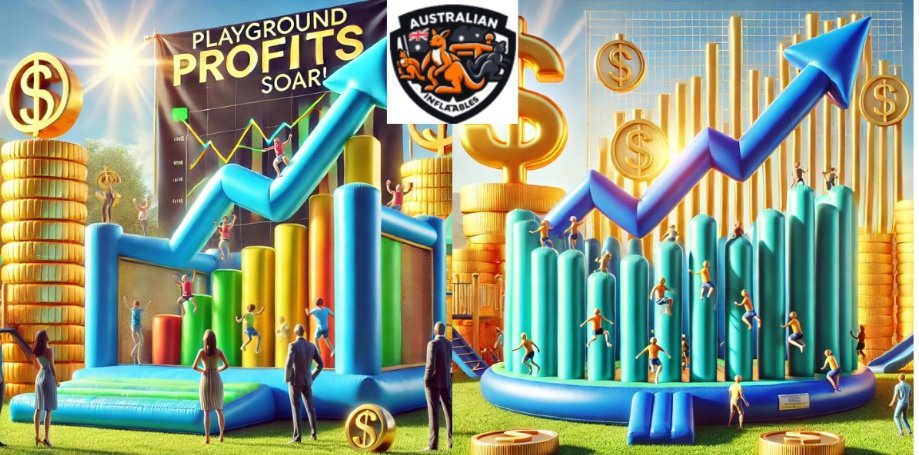In a dynamic world where consumer spending is increasingly directed toward recreational and experiential activities, the market for jumping castles and playground structures is experiencing remarkable growth. Once seen merely as children’s party accessories or basic park amenities, these installations have evolved into multifaceted investments with diverse revenue streams. Today, they are recognized not only as fun-filled play zones but also as smart investment assets that offer substantial returns for both private enterprises and public institutions. This article explores the economic landscape of the jumping castle and playground structure industry, highlighting market developments, investment drivers, and future trends that could influence financial strategies.
The Evolution of a Niche Market
Historically, jumping castles emerged as simple inflatable attractions designed for short-term entertainment at private parties and local festivals. Over the past few decades, advancements in materials technology and design innovation have transformed these inflatables into complex, multi-use structures. Manufacturers now utilize commercial-grade PVC and robust air-blower systems to build installations that are safe, durable, and customizable. Similarly, permanent playground structures are being reimagined with modern design philosophies that incorporate interactive and sensory elements, thereby broadening their appeal to families, educational institutions, and urban planners.
Market Drivers and Investment Opportunities
Expanding Consumer Demand
The rising demand for experiential leisure activities is a key driver of market growth. Consumers value experiences over material goods today, and families are increasingly seeking out safe, engaging venues for outdoor play. This trend not only boosts direct sales and rentals of jumping castles but also supports ancillary revenue streams such as event management, safety inspections, and maintenance services.
Corporate and Municipal Investment
Beyond the consumer market, institutional investors are taking notice. Municipalities aiming to revitalize public parks and community centres are investing in modern playground structures that foster physical activity and social cohesion. Similarly, corporations—through their corporate social responsibility (CSR) programs—are funding the installation of recreational equipment to promote community engagement and enhance brand visibility. For private investors, entering the market through rental or sales businesses has become an attractive proposition, given the recurring revenue potential and relatively low maintenance costs compared to other capital assets.
Technological Innovation and Themed Attractions
The integration of technology is reshaping the recreational market. Today’s jumping castles often incorporate LED lighting, interactive sound systems, and even augmented reality features that transform a simple bounce house into an immersive experience. These innovations not only boost user engagement but also allow for premium pricing, enhancing the revenue potential of these structures. Investors looking for novel revenue streams will find themed attractions particularly appealing, as customization further strengthens the competitive edge in an increasingly saturated market.
Economic Impact and Return on Investment
Revenue Potential and Profit Margins
The economics of jumping castles and playground structures are underpinned by relatively low production costs and high rental margins. Rental businesses, in particular, benefit from the ability to reuse assets across multiple events. When managed efficiently, these ventures can yield attractive profit margins. For instance, an inflatable rental unit can generate recurring income during peak event seasons, and with proper maintenance, the equipment can have a shelf life of several years, increasing the return on initial capital expenditure.
Public-Private Partnerships
Government agencies are also exploring public-private partnerships (PPPs) as an effective means of integrating recreational structures into community infrastructure. Such partnerships not only distribute the financial risk but also guarantee a steady stream of maintenance and operating revenue. By leveraging these synergies, both public entities and private investors can benefit from enhanced community engagement and infrastructural development without shouldering the entire financial burden individually.
Impact on Local Economies
Investments in recreational infrastructure contribute significantly to local economic development. Modern playgrounds and innovative jumping castles attract families, which in turn boosts foot traffic in local commercial neighborhoods. This increased patronage supports small businesses and can even raise local property values by enhancing the overall quality of life in the area. In this way, spending on recreational infrastructure is not just an isolated investment—it has far-reaching economic benefits that support the growth of entire communities.
Challenges and Managing Risks
Regulatory Compliance and Safety Standards
Despite the significant potential, investors must navigate a landscape of stringent safety and regulatory requirements. Both temporary and permanent play structures must comply with safety standards set by local authorities and international bodies. Ensuring regular inspections, adherence to manufacturing guidelines, and timely maintenance are critical for mitigating risks. While these requirements add to operational costs, they are essential for safeguarding user safety and preserving the long-term viability of the investment.
Market Saturation and Competition
Another challenge is market saturation in certain regions where the demand for rental units might be high. Investors must conduct thorough market research before diving into the market. Differentiation through innovative design, superior customer service, and strategic geographic targeting can mitigate competitive pressures and open up new market segments. Investors who understand local demands and customize their offerings accordingly are better poised to succeed.
Economic Fluctuations
Like many sectors, the recreational market is not immune to broader economic fluctuations. Periods of economic downturn or reduced discretionary spending can impact event bookings and municipal budgets. Investors must prepare for such cyclical variations and consider diversified revenue strategies, including long-term leases, corporate sponsorships, and innovative financing models that mitigate the impact of economic headwinds.
Future Outlook: Shaping the Next Generation of Play
Sustainable and Eco-Friendly Designs
The future of the industry is increasingly tied to sustainability initiatives. Investors and manufacturers are exploring eco-friendly materials and production processes designed to reduce environmental impact. The adoption of recycled and recyclable materials not only responds to regulatory pressures and consumer preferences but also opens up new markets where sustainable investments are sought after. As environmental, social, and governance (ESG) criteria become central to investment decisions, companies that integrate green technology into their recreational products will likely enjoy a competitive advantage.
Customization and Adaptive Use
The continued evolution of consumer preferences is driving a demand for more customizable and adaptable recreational equipment. Modular playground structures that can be reconfigured to suit various events or community needs are gaining traction. This flexibility ensures that investments remain relevant over time, offering a mix of short-term rental revenue and long-term public use. For investors, the ability to tailor installations to meet diverse needs is a strong selling point that can secure a broader customer base and reduce market risk.
Final Thoughts on a Bouncing Future
For financial stewards seeking assets with both immediate and long-term return potential, the recreational play sector is an exciting prospect. While challenges such as regulatory compliance and market competition exist, the overall trajectory remains positive. Innovative companies that stay ahead of market trends and integrate smart technologies will likely set new benchmarks for success. With thoughtful planning, diligent risk management, and a focus on community impact, investments in jumping castles and playground structures can yield substantial rewards, proving that even in the realm of play, serious business opportunities abound.
Investors, community planners, and industry stakeholders are now witnessing a convergence of fun and finance—a testament to how play infrastructure can drive economic growth while enriching community life. As the sector bounces back stronger than ever, it is clear that the future of recreational investments is bright, dynamic, and full of untapped potential.









